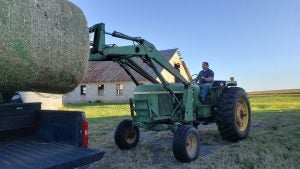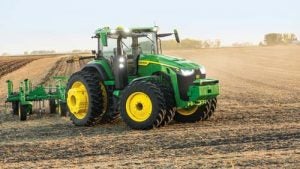Old tractors are a mainstay of small and large farms alike. Growing up on a family operation in the 1980s, it was just expected that the baling of hay would be done on a tractor from the 1950s. Fast forward to 2023 and that same tractor might still be there running this summer. For farmers, technology might change, but not the two-fold strategy of watching expenses and managing one’s tax liability.
Certified Public Accountant Michelle Rodgers of the Rodgers CPA Group LLC in Brazil, Indiana, observed that agricultural producers can indeed benefit from tax strategies involving deprecation, and in many cases, it’s better to keep an old machine than have to pay taxes on the cash from a sale.
Also, considering the price of new equipment these days, smart farmers do what they can to maximize the life of their equipment.
Rodgers has spent nearly 20 years in her field, working in the rural west-central region of Indiana ripe with small- and mid-sized farms. She said there are quite a few differences between each of the states’ tax codes and that of the federal, with regulations changing every year.
“Usually every year the amounts are indexed for inflation,” she said. Producers and operators at all levels are advised to consult with their own tax specialist when it comes to their business strategy. But below are some points to consider, because sometimes equipment just isn’t worth selling.
Tax strategy
Business owners of all kinds understand deprecation as a concept, whereby a piece equipment is valued a bit less each year it’s in use. Depending on the property or equipment in question, the depreciation follows a different schedule of percentage points and years until it’s effectively zeroed out. Once a piece of equipment has been fully depreciated, any cash realized from the sale becomes taxable income. In the case of used farm equipment these days, that could be a sizeable number of dollars.
Depending on the total revenue and tax liability of the farm, the proceeds from a tractor sale could wind up being negated when factored into the gross farm income. For instance, a $100,000 receipt for the sale of a tractor could bump someone into the next tax bracket, and depending on what their farm’s gross income was, increase the tax liability significantly. Many farmers simply decide to keep their old machines as it isn’t worth the hassle.
Rodgers said tax-wise, new farm equipment can be depreciated over five years, while equipment purchased used can be spread over seven. So equipment older than that would probably be zeroed out by now.

As a point of information, farmers should consider that in 2023 for taxes to be filed in 2024, there’s an improved opportunity to use the Section 179 Deduction for farm equipment. A Section 179 expense is a deduction farm owners can use in one lump sum when purchasing machinery, instead of capitalizing it and depreciating it over time of five years. This year, farmers could use this strategy for up to $1.16 million on qualifying purchases up to $2,890,000, she said.
Producers might also be interested to know that Section 179 Deductions can also be used for breeding livestock, not just equipment, Rodgers said. It’s important to check with a tax preparer when considering this as the Section 179 cannot be used to create loss on paper. Also, in Indiana, the state caps Section 179 Deductions at $25,000 for state tax purposes, and producers should check to see what their state requirements are.
Meanwhile, even though the Section 179 Deduction can’t be used to generate a loss, the federal government offers a bonus depreciation schedule which can help. In 2023, the bonus depreciation for federal purposes is 80 percent of purchase price, with the 2024 bonus at 60 percent, 2025 40 percent, 2026 20 percent, and 0 percent on 2027 and later.
Bonus depreciation elections are made by asset class, whether newer equipment at five years, or used at seven years, meaning the producer needs to work with their tax adviser and let them know what kind of equipment is being selected. As a rule, Rodgers said she advises against expensing equipment that has been financed. As the producer continues to pay on the equipment in future periods, they’re stuck without a tax deduction as it’s been used up. Cash purchases are different, she said.

Working with a good tax preparer is crucial these days, as many producers combine farm income with one or two full-time jobs. Proper bookkeeping and understanding of the state and federal tax code can make all the difference when trying to determine the impact of buying, selling, or trading pricey equipment. Which brings up the second point for agriculture producers …
Buying and maintaining farm equipment is pricey
It’s a mixed bag when farmers consider how much money they could make by selling used equipment this year. Prices for used equipment were hot in 2022 as new machines were scarce. Supply is a bit better in 2023. As Rodgers explained, selling a used tractor could generate a big cash receipt that winds up biting the farmer tax-wise. But then the bigger question is, can you really justify the cost to replace it? Or worse, will you be able to afford maintenance?
Ever since the COVID-19 pandemic disrupted global supply chains, inflationary stresses in the agricultural world have been fierce. Granted, May 2023 corn was pricing at $6.50 per bushel and soybeans $15.19 as of February 24, but diesel fuel was also averaging $4.58 per gallon. The cost of inputs and other everyday items have made the strong markets a mixed blessing indeed.

Meanwhile, John Deere’s sales website lists the 9R 540 at $550,000, with an 8R 230 coming in at $280,000. While John Deere has a historic presence in the market, it’s also among those manufacturers identified in “Right to Repair” legislation in states across the U.S. Those top John Deere models come fully equipped with the latest and greatest technology, which makes repairs quite costly. Even if the farmers know how to maintain and repair them, and have the tools to do, they might be prohibited from it. Affording the new tractor is one thing, but the cost of maintenance is another big plug for keeping old faithful.
Used equipment auction site Big Iron had a 1989 Case 9170 tagged at just $14,000 as an example. Maintaining that machine is simply a matter of finding the parts.
Not just for show
Granted, there is something idyllic about driving through rural areas and seeing old farm machinery still in use. To the passerby this might be an afterthought, or perhaps they figure farmers like antiques. There’s some truth to that, and many a farmer appreciates a good renovation job on a machine they remember from their childhood.
But these days, between the taxes and the cost of new equipment, business is probably coming first, and producers are looking to use their equipment as long as possible.
Brian Boyce is an award-winning writer living on a farm in west-central Indiana. You can see more of his work at the Boyce Group homepage.


